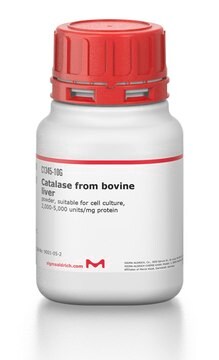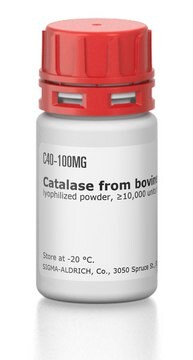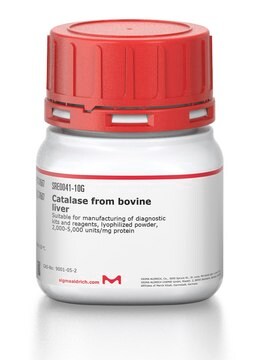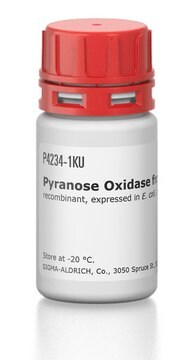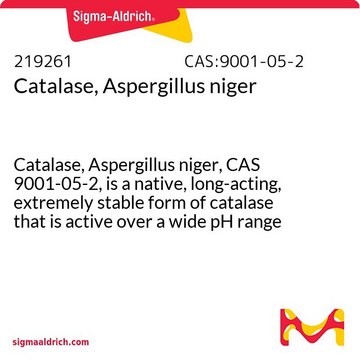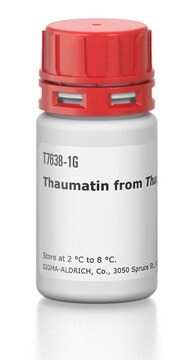E3289
Catalase from bovine liver
≥20000 units/mg protein, lyophilized powder
Sinónimos:
H2O2:H2O2 oxidoreductase
About This Item
Productos recomendados
Formulario
lyophilized powder
Nivel de calidad
actividad específica
≥20000 units/mg protein
mol peso
tetramer ~250 kDa
composición
protein, ≥60% E405
punto isoeléctrico
5.4
Condiciones de envío
wet ice
temp. de almacenamiento
−20°C
InChI
1S/C9H10O3/c1-2-12-9(11)7-3-5-8(10)6-4-7/h3-6,10H,2H2,1H3
Clave InChI
NUVBSKCKDOMJSU-UHFFFAOYSA-N
¿Está buscando productos similares? Visita Guía de comparación de productos
Descripción general
Catalase is encoded by the gene mapped to human chromosome 11p13. Mammalian catalase is an antioxidant enzyme and is a member of hydroperoxidase family). The active enzyme is homotetrameric in nature.
Catalase from bovine liver is a tetramer consisting of 4 equal subunits each with a 60 kDa molecular weight. Each of these subunits contains iron bound to a protoheme IX group. The enzyme will also strongly bind to NADP, where NADP and the heme group are within 13.7 angstroms.
Aplicación
- as a component of gloxy, which is one of the most popular oxygen-scavenging systems.
- in single molecule fluorescence resonance energy transfer (FRET) measurements.
- in cytochrome-C oxidase (COX) histochemistry to study the role of mitochondrial uncoupling protein 2 (UCP2) in limiting oxidative stress during glaucoma.
- to pre-treat slide chambers for total internal reflection fluorescence (TIRF) microscopy.
- in quantifying hydrogen peroxide release.
- to help minimize the effects of reactive oxygen species (ROS) in cooperativity assay for studying doublecortin and microtubule interaction.
Catalase from bovine liver may be used:
- to prepare H2O2-O2 based biocathode for applications in glucose biofuel cells
- to study the kinetic properties and storage stability of catalase immobilized on to florisil
- in glutathione-mediated superoxide generation in an aqueous solution
Acciones bioquímicas o fisiológicas
Definición de unidad
Forma física
Palabra de señalización
Danger
Frases de peligro
Consejos de prudencia
Clasificaciones de peligro
Resp. Sens. 1
Código de clase de almacenamiento
11 - Combustible Solids
Clase de riesgo para el agua (WGK)
WGK 1
Punto de inflamabilidad (°F)
Not applicable
Punto de inflamabilidad (°C)
Not applicable
Elija entre una de las versiones más recientes:
Certificados de análisis (COA)
¿No ve la versión correcta?
Si necesita una versión concreta, puede buscar un certificado específico por el número de lote.
¿Ya tiene este producto?
Encuentre la documentación para los productos que ha comprado recientemente en la Biblioteca de documentos.
Los clientes también vieron
Nuestro equipo de científicos tiene experiencia en todas las áreas de investigación: Ciencias de la vida, Ciencia de los materiales, Síntesis química, Cromatografía, Analítica y muchas otras.
Póngase en contacto con el Servicio técnico
